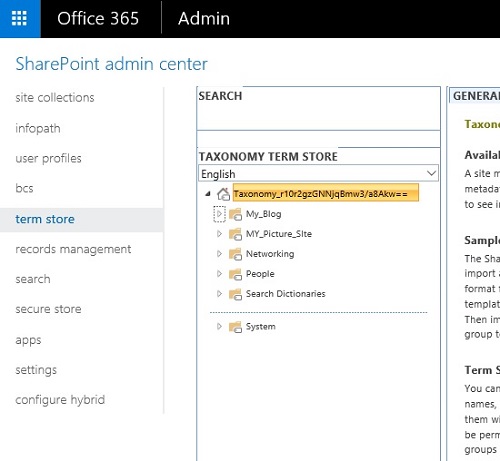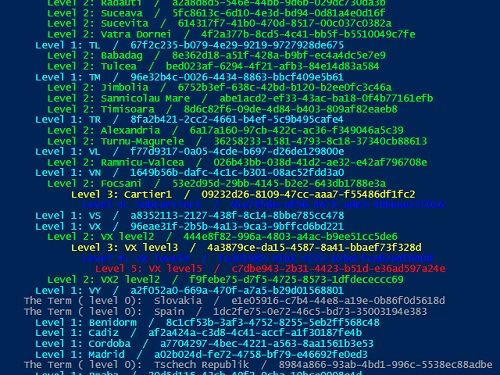SharePoint Online Taxonomy - Output Terms up to 6 level with PowerShell and CSOM
As you know, SharePoint taxonomy refers to a catalog of objects in your SharePoint environment or the process of categorizing or classifying objects based on a taxonomic scheme.
The taxonomy is structured like below:
The Termstore -
Groups
Termset
Term ( level 0 )
Term ( level 1)
Term ....
The structure could be deeper as you need, but a very deep structure will not help you to keep real structured information on your tenant. (It is recommended maximum 3-4 level deep for terms.)
If you run it on a machine without SharePoint installed on it, you will need 2 DLLs: Microsoft.SharePoint.Client.dll and Microsoft.SharePoint.Client.Taxonomy.dll (you can copy them from SharePoint server).
The script in PowerShell using CSOM proposed is this one:
$url=Read-host "Introduce your tenant's URL"
$cred = Get-Credential
Add-Type -Path "\\path\Microsoft.SharePoint.Client.dll"
Add-Type -Path "\\path\Microsoft.SharePoint.Client.Taxonomy.dll"
$clientContext = New-Object Microsoft.SharePoint.Client.ClientContext($url)
$credentials = New-Object Microsoft.SharePoint.Client.SharePointOnlineCredentials($cred.username, $cred.Password)
$clientContext.Credentials = $credentials
############# Get your tenant Taxonomy details ##################
$MMS = [Microsoft.SharePoint.Client.Taxonomy.TaxonomySession]::GetTaxonomySession($clientcontext)
$clientContext.Load($MMS)
$clientContext.ExecuteQuery()
$TermStores = $MMS.TermStores
$clientContext.Load($TermStores)
$clientContext.ExecuteQuery()
#Bind to Term Store
$TermStore = $TermStores[0]
Write-Host "################################# Taxonomy on tenant which contain the Site collection #################################"
Write-Host "################################# $url #################################"
$clientContext.Load($TermStore)
$clientContext.ExecuteQuery()
""
$Groups = $TermStore.Groups
$clientContext.Load($groups)
$clientContext.ExecuteQuery()
for ($i = 0; $i -lt $Groups.Count; $i++)
{
write-host "For the Group: "$groups[$i].Name " / " $groups[$i].id
$groupname =$groups[$i]
$termsets = $groupname.TermSets
$clientContext.Load($termsets)
$clientContext.ExecuteQuery()
foreach ($termset in $termsets ){
write-host " The TermSet:"$termset.Name " / " $termset.id -ForegroundColor DarkYellow
$terms = $termset.Terms
$clientContext.Load($terms)
$clientContext.ExecuteQuery()
foreach ($term in $terms ){
write-host " The Term ( level 0): "$term.Name " / " $term.id -ForegroundColor Gray
$items = $term.Terms
$clientContext.Load($Items)
$clientContext.ExecuteQuery()
foreach ( $term_level1 in $items ){
Write-Host " Level 1:" $term_level1.Name " / "$term_level1.ID -ForegroundColor cyan
#$term_level1.TermsCount
$items2 = $term_level1.Terms
$clientContext.Load($Items2)
$clientContext.ExecuteQuery()
foreach ( $term_level2 in $items2 ){
# $term_level2.TermsCount
Write-Host " Level 2:" $term_level2.Name " / "$term_level2.ID -ForegroundColor green
$items3 = $term_level2.Terms
$clientContext.Load($Items3)
$clientContext.ExecuteQuery()
foreach ( $term_level3 in $items3 ){
#$term_level3.TermsCount
Write-Host " Level 3:" $term_level3.Name " / "$term_level3.ID -ForegroundColor yellow
$items4 = $term_level3.Terms
$clientContext.Load($Items4)
$clientContext.ExecuteQuery()
foreach ( $term_level4 in $items4 ){
#$term_level4.TermsCount
Write-Host " Level 4:" $term_level4.Name " / "$term_level4.ID -ForegroundColor blue
$items5 = $term_level4.Terms
$clientContext.Load($Items5)
$clientContext.ExecuteQuery()
foreach ( $term_level5 in $items5 ){
#$term_level5.TermsCount
Write-Host " Level 5:" $term_level5.Name" / "$term_level5.ID -ForegroundColor red
}
}
}
}
}
}
}
}
The results, deeper up to 6 levels like below. Different colors for each level and it's present in the GUID, which is useful. If you need to populate a managed metadata field in a list/library using PowerShell and CSOM on Sharepoint Online.

